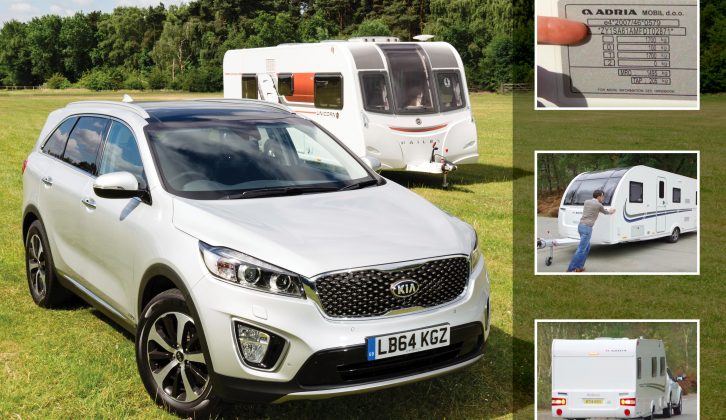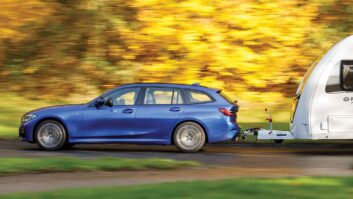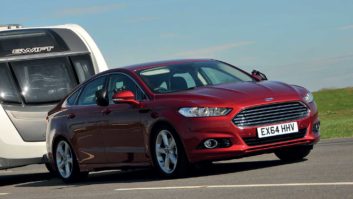Your first time away in a caravan can be both exciting and daunting. It’s the beginning of what should be a lifetime of travel, new experiences and unexpected adventures. But there can be mistakes and mishaps along the way.
Some of us are born into a caravanning family, and spent our school holidays winding down steadies and filling up Aquarolls.
But if, like me, you’ve come to caravanning as an adult, there’s a lot to learn to make caravan holidays safe and enjoyable.
Even if you did caravan as a child, there will be lots to learn about towing and outfit matching.
The list of things every new caravanner should know could go on and on. I’m making five points, but I’m certainly not suggesting that’s a comprehensive list. Please do add more of your own on our forum, or on Practical Caravan‘s Facebook, Twitter or Google+ pages.
1. Know what you can tow
What can I tow? This one can easily catch out a new caravanner, especially if you are relatively young as well as a newcomer to caravanning and towing…
If you passed your driving test on or after 1 January 1997 and haven’t taken a towing test since, then you have a B licence. This allows you to tow a car with a Maximum Authorised Mass (MAM) of 3500kg towing a trailer or caravan with a MAM of up to 750kg.
If that was as far as the rules went, that would pretty much rule out caravanning with all but the lightest of tourers. However, the law allows B licence holders to tow caravans weighing more than 750kg, provided the MAM of the car and caravan added together does not exceed 3500kg.
So, maybe you’re a 30-something caravanner who passed their test in 1997. You have a car with a MAM (also known as the gross vehicle weight) of 2200kg. That leaves 1300kg for the caravan (2200kg + 1300kg = 3500kg).
Remember, it’s the MAM (which for caravans is often referred to as the Maximum Technically Permissible Laden Mass) which counts here, not the empty weight or even the true weight of the van when loaded. So don’t think you can get around the licence rules by keeping the actual weight of either the tow car or caravan well below their maximum figures.
Maybe a 1300kg caravan isn’t big enough for your needs. Are you stuck towing with an unsuitable caravan?
No, you can take a towing test to upgrade to a ‘B+E’ licence, which is what all of us old-timers have anyway. This means you can tow a car and trailer with a combined MAM of up to 8250kg. That’s significantly more than any car and caravan combination you are ever likely to drive.
Passing your test isn’t a forgone conclusion, though, which is where some training will come in very handy…
2. Learning to tow will make you a better driver
Any safe and responsible driver should be able to tow safely with practice, but there are extra skills to learn. Some pick up the extra knowledge through experience, but the best and safest way is to spend some time on a towing course.
There’s been an explosion in trailer training in recent years, with B licence holders looking to upgrade. But clearly younger drivers aren’t without some special knowledge that the rest of us were born with.
Even if you don’t need to take a test to legally tow the caravan of your dreams, a course will boost your skills and confidence, and teach you how to manoeuvre safely once you reach your destination.
Both The Caravan Club and The Camping and Caravanning Club offer courses to suit both novice caravanners and those looking to improve their driving. I took a course when I started out and found it enormously helpful.
3. The 85% rule is really a guideline
Safely matching a car and caravan takes care, and the knowledge of a few basic facts and figures.
Before you think about buying a caravan, check if you can legally tow it behind your current car with your driving licence. Also make sure it can legally be towed behind your car: any vehicle which has been approved for towing will have a legal towing limit, which shouldn’t be exceeded.
If the combination you are thinking of is legal on both counts (in other words, you can drive the car and caravan combination with your licence and the caravan can be towed behind your car without exceeding its towing limit), then you can decide if it is a safe and sensible match.
This is where the waters become more murky. Caravanners often talk about ‘the 85% rule‘. To stick to this rule, the caravan should weigh no more than 85% of the kerbweight of the tow car.
The trouble is, it is not a ‘rule’ in the sense of being hard and fast, or in the sense of being a legal requirement.
It’s better thought of as a guideline, and both major caravanning clubs suggest it’s particularly applicable to newcomers to towing. For more experienced tow car drivers, the big clubs advise that matches of 85-100% are acceptable.
My problem with the description of this guidance as a rule is that it can create the impression that if you tow no more than 85% of the kerbweight of your car you’ll be safe as houses.
There’s a lot more to considerate and responsible towing than that, not least how the caravan is loaded. Heavy items should be secure, low down, and close to the caravan’s axle (or axles). If the van has lots of weight at either end (especially at the back) it can quickly become unstable.
Tyres need to be in good condition and inflated to the correct pressure with plenty of tread left. Speed needs to be matched carefully to road conditions, which may mean driving below the legal speed limit.
I’d rather tow at 90-95% with a carefully loaded caravan, than tow at 85% with a tourer that’s unevenly loaded with under-inflated tyres.
So, the 85% guideline should be taken seriously by anyone new to towing. But all the other factors which contribute to save and stable towing should be remembered, too.
4. Join a club
If you are going to start caravanning, it makes sense to be a member of one of the two big clubs (The Camping and Caravanning Club and The Caravan Club).
In fact, if the caravan bug bites hard it may be best to join both – some sites are only open to members, and joining these two clubs will give the widest possible choice of destinations.
Joining either club means lower priced pitches, as well as discounts on other goods and services.
5. Caravan movers aren’t cheating
Everyone would like to be able to reverse a caravan perfectly. But some people never quite get the hang of it.
By all means practise, take manoeuvring courses, and work on perfecting this skill. But if reversing never quite clicks, don’t be afraid to use a caravan mover instead.
You probably know what a caravan mover is but, for uninitiated newbies, a mover is an electric drive system using rollers that engage with the caravan’s tyres. You unhitch, get out of the car, and let the mover do the work, typically using a remote control.
There are disadvantages to movers, not least their weight (which effectively reduces the caravan’s payload) and cost (several hundred pounds or more). But despite what some old hands will tell you, using a mover is not an admission of failure.
You’re on your holidays. It’s supposed to be fun. If a mover takes the hassle out of arriving on site, then why not?
Because, after all, having fun on your caravan holidays is what it’s all about, however near or far you travel, whatever time of year. And if you’ve got any other questions, head to our forum and get chatting with plenty of friendly, like-minded folk.
Taking a towing course will boost your skills and confidence









